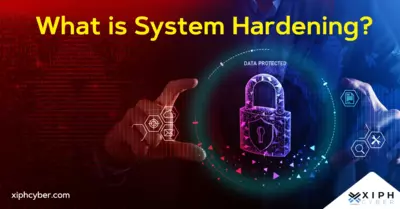Published May 31, 2023 by Xiph
Vulnerabilities plague all networks, putting precious data, business operations, and brand reputation at risk. One of the best ways to protect your enterprise – big or small − from cyber attacks is to ‘harden’ your operating systems.

What is system hardening?
System hardening is a catch-all term that describes the tools, techniques, and methods used to minimise (or preferably eliminate) vulnerabilities in servers, computers, web applications, operation systems, firmware, and other areas. System hardening reduces network and information technology (IT) ecosystem risks by eliminating potential attack vectors and security flaws, narrowing attack surfaces, and limiting the impact of any compromise.
How does system hardening work?
System hardening involves auditing, identifying, and eliminating any potential security vulnerabilities in your business network and operating systems. The best way to harden your systems is to patch your security flaws, limit user privileges and access, ensure adequate encryption, and disable non-essential services. System hardening should be enforced throughout all technologies’ lifecycles, from initial installation, through configuration, maintenance, support, and end-of-life decommissioning.
Types of system hardening
System hardening can (and should) be applied to all layers of an organisation’s IT infrastructure to cover all bases. The main types of system hardening include:
- Application hardening: Adjusts application settings at the host level, operating system level, user level, etc. Common defence layers include obfuscation and cryptography, authentication hardening, whitelisting, etc.
- Operating system hardening: Reduces vulnerabilities in operating systems on servers and endpoints. This includes updating security patches, removing unnecessary services/drivers, limiting access and authenticating system access permissions, removing unnecessary accounts, etc.
- Network hardening: Fortifies network infrastructure by configuring firewalls, applying robust encryption standards, implementing intrusion detection and prevention systems, disabling harmful network protocols, conducting regular vulnerability assessments, etc.
- Database hardening: Analyses and configures databases to address security vulnerabilities. This includes adopting role-based access controls, encrypting sensitive data, and adjusting security settings.
- Server hardening: Secures servers or computer systems by patching vulnerabilities and turning off non-essential services. This includes disabling unnecessary system applications, permissions, ports, user accounts, etc.
- Endpoint hardening: Secures the endpoints of devices by updating endpoint protection platforms, examining files, etc.
- Remote system hardening: Protects remote systems and devices by implementing secure access controls and protocols, and monitoring for vulnerabilities and threats.
Why is system hardening important?
The obvious benefit of system hardening is that it improves your business’ overall security posture and cyber attack resilience and limits the propagation of malware if it hits your network. But that’s not all. It can also improve your system performance around the clock once configurations are reviewed and help with better auditing since digital assets and resources are reduced to the minimum. System hardening is also low-cost compared to the financial impact a cyber breach could have on your business.

Tips and guidelines for system hardening
Hardening your network system is not rocket science but does require planning and preparation. System hardening is a variable process depending on the type and size of your business. However, the same universal protocols apply.
Evaluating the system’s components and network
Before implementing any security measures, it’s important to evaluate your network system components including all hardware, software, servers, protocols, and connections. This will help prioritise the systems to be hardened from most critical to least and identify unnecessary services or drivers that can be removed.
Read more: Business attack surfaces & cyber risks
Lock configurations
Review and lock operating system and network configurations to minimise management errors, and limit certain functionalities. This will reduce the attack surface and possible threats to your IT infrastructure. Some configuration management standards to use as reference could be NIST, CIS, and STIG.
Encrypt all your network traffic and data
Encrypt all your network traffic, files, and data to protect against unauthorised access. Data should be encrypted both at rest and in transit. In addition to encryption, you should implement strict access controls and adjust security settings on your databases. You can also restrict access to specific file types like executable files.
Limit access controls
Protect your network and systems by implementing the principle of least privilege and identity and access management (IAM). These security methods strike the right balance between usability and security of critical resources by ensuring that users are only given permission to resources and information that they need to perform their job functions. It’s also important to restrict access to privileged functions, such as user account management and system configuration to prevent unauthorised changes to the system. Use application whitelisting to establish a list of approved programs allowed to be accessed by users.
Read more: What is IAM? Identity and access management explained
Eliminating unnecessary software or services
Disable all unnecessary software and applications that are not needed for your system’s intended scope of work. You should also eliminate unnecessary functionalities, redundant OS components, services, and drivers. This can reduce entry points for malicious actors and make it harder to crack into your system.
Use advanced security measures
Bolster your cyber security posture with some advanced security tools like multi-factor authentication (MFA), next-generation firewalls, intrusion detectors, spam/email filtering, antivirus software, cyber security analytics, etc.
Read more: Cyber security analytics guide
Regular backups
Hardened systems need to back up data and sensitive resources. Businesses should use the 3-2-1 method of backup – this involves making three copies of your data, two local (on identical but separate hard drives), and one offsite in cloud storage. Test your ability to restore the backups.
Read more: Why your business needs a data backup plan NOW
A final word
System hardening is important but even more so is to keep updating your system hardening techniques to protect your business from ever-evolving threats. Perform regular risk assessments and tweak your hardening strategy accordingly. For more information on best practices, contact us via email: enquiries@xiphcyber.com.
Posted in: Security


